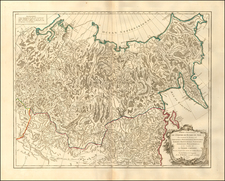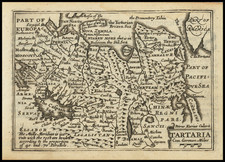Nature and Violence during the Soviet Purges.
Fascinating color-printed Soviet pictorial map depicting mammal hunting throughout the USSR.
The map was composed by one of the foremost Soviet children's authors, Vitaly Bianki, whose works primarily focused on animals, and executed by Ivan Riznich, an artist whose usual output was porcelain renditions of animals.
Allegorical and anthropomorphic storytelling was an important method by which Soviet authors could circumvent censors and communicate dissenting opinion and morals.
The image is truly an engaging and troubling one, perhaps reflective of the political and social climate in the USSR in the 1930s. While it initially appears to be a bucolic children's book illustration, on closer inspection, the map shows humans brutally trapping and gunning down every sort of mammal across the entire width of the Soviet Union. The map was produced just after the height of the Great Purge (1936-38) and speaks to a nation overrun with violence and predation. While on its face, the map would have been commissioned to promote the bounties of Soviet nature, it speaks to something darker.
One can read too much into such an image, but Bianki was intimately acquainted with the brutality of the Soviet state; he repeatedly fell afoul of authorities during the '20s and '30s. At the end of 1925, he was arrested on suspicion of subversive activity and sentenced to three years of exile in Uralsk. In the spring of 1928, he was released to return to Leningrad. In November 1932 was arrested again, but was released after three and a half weeks for lack of evidence. In March 1935, he was arrested as an "active member of the armed uprising against Soviet rule" and taken to the Aktobe region, but was released after intercession by Maxim Gorky's ex-wife, Yekaterina Peshkova. In 1941, he returned to Leningrad. Because of poor health he was not drafted to serve in the army for World War II, but was evacuated to the Urals. After the war he returned again to Leningrad.









![[St. Petersburg] Grundriss der Festung Statt und Situation St. Petersburg](https://storage.googleapis.com/raremaps/img/small/92259.jpg)
![[Hydrographic Map of European Russia] ГИДРОГРАФИЧЕСКАЯ КАРТА ЕВРОПЕЙСКОЙ РОССИИ](https://storage.googleapis.com/raremaps/img/small/54482.jpg)


![Drink Norden Kaffe [Russia]](https://storage.googleapis.com/raremaps/img/small/91603.jpg)
